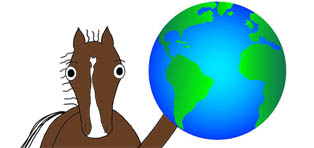Independent.ie full article
Tuesday October 02 2007
One hundred miles: a return trip from Dublin to Portlaoise. You could drive there, take a bus there, even hop on a train, but would you ride it?
Imagine how long it would take. Would your horse carry you that far? Would you be able to stay in the saddle for that long?
Endurance riding is a relatively new sport to Ireland, but there are a small number of top endurance riders in this country who set both themselves and their horses the grueling task of completing a 100-mile race.
Kevin Croke is chef d'equipe and high performance manager of the Irish endurance riding team, as well as a director of the Irish Long Distance Riding Association (ILDRA).
"It's a very specialised sport and it takes three years or more to get a horse to the stage where it can compete in a 100-mile race," he explains. "If someone was looking for a 100-mile horse, they would pay good money for it."
By far the most common breed used in endurance racing is the Arab or some type of Arabian cross. "They originally come from the desert and were bred to travel long distances," explains Kevin's daughter Yvonne, who is herself an international competitor.
With a European endurance champion Arab stallion at home, as well as a half-bred Arabian cross and a three-quarter Arab, she is enthusiastic about the breed.
"We have bought some mares to try and breed what we think is the best type of horse for endurance riding," Yvonne explains. The aim is that the foals sired by her two stallions at Delour Valley stud to thoroughbred mares will be crossed back again to Arabian stallions to make the ideal endurance horse.
"The Arab's fundamental qualities are stamina and endurance," she says, before adding that she found Arabs very loyal.
"They will just go and go for you. That goes back to when they would have been taken into the tents by their owners in their native desert home," she says.
However, there is room for more than one breed in long-distance riding and one of her horses, Salubrious Diamond, has roots in traditional Irish breeding.
"Diamond is three-quarters Arab, three-eighths thoroughbred and one-eighth Irish Draught -- he has King of Diamonds on his dam's side," says Yvonne.
Veterinary knowledge and an intuitive grasp of how the horse is coping with a long distance are paramount in a long distance race because there is no point in pushing your horse to finish first if it is then eliminated from the race by the vet. "You need to understand your horse, how it is feeling, you need to be able to read it," explains Yvonne.
"There is a point where the horse, or even the rider, hits 'the wall' and the difference between the best riders and the rest is that the best riders know when they've hit the wall," Kevin says.
"They need to adjust the pace, slow down and both horse and rider must be able to take in food and water, even if their body is saying it doesn't want it," he says.
"But it can sometimes be too late, a bit like putting oil in the car when the light is on: there is already some damage done."
The diet of an endurance horse is linked closely with its performance, and the animals are fed a high concentration of vegetable oils like soya oil and sunflower oil. The benefit of oil is that it gives a slow energy release without the 'fizz' associated with feeding oats.
"As well as that, horses are 30pc warmer without corn in the diet," explains Kevin.
High amounts of protein are also avoided in the diet, because this can make the horse prone to tying up. "We only feed a 10pc protein mix."
For international competitions, there is a mandatory minimum weight of 75kg that the horse must carry, which includes both rider and tack.
"I think around 20pc of the horse's own weight is the maximum he should carry, so, for a horse of 405kg, the target weight should be around 81kg," says Kevin. "If the riders aim for the minimum weight, they could lose weight during the ride and get eliminated, so it is safer to aim for little bit above the minimum."
As regards age, horses must be at least seven years old before they can compete in long distance races.
"Endurance horses are at their best in their teenage years," says Kevin.
"Older horses don't have too many problems, as long as you take care of them. You have to put in a very good foundation to increase the strength of the tendons and muscles," he explains.
"We walk the horses for six weeks before they get a single trot and even then we don't hammer the roads."
Although endurance riding originated in the Middle East, its popularity spread rapidly to the west and throughout Europe.
One of the top Irish endurance riders, Emer Lennon, proved that Irish riders can compete against the best in the world when she finished 34th in the World Equestrian Games.
With her horse, Damascus D'Azat, Emer began the 160km ride against 159 other competitors, including three other Irish combinations: George Finlay and Flint; Emily Miller and DVS Tahini; and Iona Rossely and Auscot Park Astra.
With the other three Irish pairs knocked out at vet gates three and five, Emer completed the race with an average speed of 14.86km/hr in a race which saw 94 of the 159 starters fail to complete the course.
For anyone interested in the sport of long distance riding, the season generally starts in January and runs through to the end of October, although there may be rides throughout the year. The introduction to long distance riding is the pleasure ride, which is open to both members and non-members of the ILDRA.
Ridden over a distance of less than 20 miles, most pleasure rides take less than two hours to complete and are how most riders first get involved in endurance riding.
Pleasure rides (PRs) are just that: rides that are for pure pleasure. There is no competitive element, although there is a trophy awarded each year to the member who has accumulated the highest PR miles during the year.
Riders must be at least six years old and horses at least four years old before they can start pleasure riding. Juniors must ride with an adult accompanying them until they are fourteen years old and adults can only accompany two juniors at a time. So what happens on a pleasure ride?
A typical day will begin between 10.30am and 12.30am when the organisers will explain the route for the day and you will pay your fee of around €10-15. Maps of the route are distributed to each rider, as well as contact mobile phone numbers in case of emergency.
Although some people prefer to ride individually, most people end up riding in groups of two or four, following the route which is marked out with orange tape and yellow spray paint.
Moving onwards from the pleasure ride, the next step for horse and rider is the competitive trail ride (CTR). A CTR is longer than 20 miles and must be ridden within a set time.
Horses must be at least five years old before starting CTRs and jockeys must be at least nine years old. The horses are vetted before and after the ride and if the CTR is longer than 40 miles, there will be at least one -- if not more -- vettings during the ride.
At the CTR stage riders are not competing against each other but working towards a series of awards called the Shamrock awards which start at bronze level and run through silver, gold, platinum and diamond levels. Gold shamrock qualification allows horse and rider to start to compete in endurance races (ERs).
To qualify for the bronze shamrock, horse and rider must take part in two qualifiers of 20 miles each and a final of 30 miles.
Bronze rides must be ridden at speeds between six and eight miles per hour, to ensure that the horse is built-up steadily without being pushed to too high a speed too early in their career.
The silver shamrock requires two rides of 40 miles each, while the gold shamrock involves two 50-mile rides. To qualify for the platinum shamrock award, the horse and rider must complete one 63-mile ride and the diamond shamrock is awarded when the pair completes a ride of 72 miles.
Tuesday, October 02, 2007
Subscribe to:
Post Comments (Atom)
FOR IMMEDIATE RELEASE SOURCE: ENDURANCE.NET AlUla Organizing Committee Commits to Track Modifications Ahead of February Showdown ALULA, KS...

-
Inside.fei.org 17 December 2020 The FEI Board took a series of key decisions on allocation, cancellation, and reopening of bids for FEI C...
-
Michael Pollard was one of the four winners of the 2025 Mongol Derby (Kathy Gabriel) Ca.News.yahoo.com - Full Article Annabel Grossman ...
-
BNA.bh - Full Article 17 Aug 2025 London, Aug. 17 (BNA): His Highness Shaikh Nasser bin Hamad Al Khalifa, Representative of His Majes...


No comments:
Post a Comment